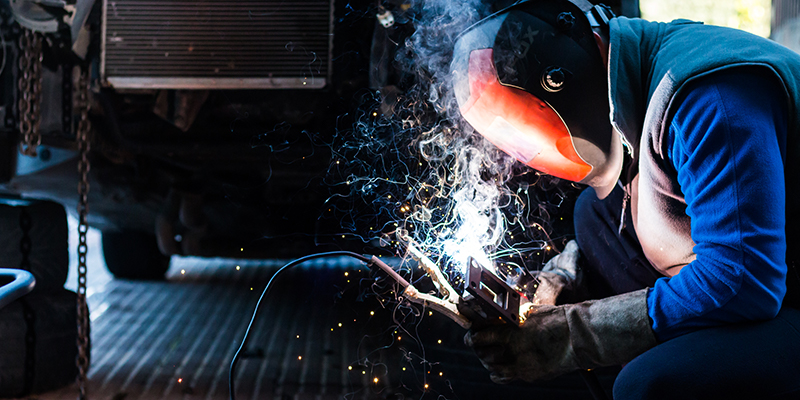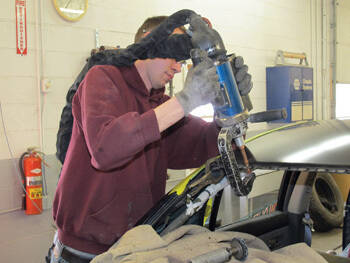Everything about Welding: Trick Insights Into Techniques and Best Practices for Success
Welding includes a range of strategies, each fit for particular materials and applications. Understanding these approaches, such as GMAW, SMAW, and TIG, is necessary for attaining optimal outcomes. Additionally, the best devices and security practices can not be neglected. As prep work and troubleshooting play critical functions in the welding procedure, mastering these elements can significantly enhance the top quality of the last item. What are the vital elements that guarantee a successful weld?
Understanding Various Welding Strategies
Welding strategies incorporate a selection of approaches, each suited to particular applications and products. Amongst the most common techniques are Gas Steel Arc Welding (GMAW), Protected Metal Arc Welding (SMAW), and Tungsten Inert Gas Welding (TIG) GMAW, also referred to as MIG welding, is prominent for its rate and versatility, making it optimal for thin materials. SMAW, or stick welding, is favored for its simplicity and performance in outdoor settings, especially with thicker metals. TIG welding uses accuracy and control, making it appropriate for detailed work and non-ferrous steels (Belgrade Fabrication). Each strategy has its special benefits and factors to consider, permitting welders to pick the very best method based upon the task's demands, product kind, and wanted results. Recognizing these strategies is essential for effective welding
Important Welding Tools and Tools
While different welding strategies call for particular skills, the appropriate devices and tools are similarly necessary for achieving high quality outcomes. Important welding tools consists of welding machines, which vary depending upon the technique-- such as MIG, TIG, or stick welding. Protective gear, including gloves, headgears, and aprons, assurances security and comfort during the process. Additionally, clamps and components aid protect materials in location, guaranteeing precision in welds. Consumables like welding poles, wire, and protecting gas are likewise essential parts that affect the quality of the weld. Furthermore, devices such as mills and cutters facilitate surface preparation and post-weld completing, adding to a specialist end result. Purchasing high-quality equipment inevitably boosts the performance and efficiency of welding tasks.
Safety Practices in Welding
Proper security practices are essential in the welding industry to safeguard employees from prospective risks. Welders must use appropriate personal protective devices (PPE), consisting of helmets with correct shading, handwear covers, and flame-resistant clothes. Ample ventilation is crucial to reduce exposure to dangerous fumes and gases produced throughout the welding procedure. Additionally, employees must be educated in the correct handling of welding devices to stop accidents. Fire precaution, such as maintaining combustible materials far from the welding area and having fire extinguishers readily offered, are required. Regular assessments of tools and work spaces can assist identify possible risks prior to they cause mishaps. By sticking to these safety and security practices, welders can develop a much safer working environment and reduce threats related to their profession.
Readying Products for Welding
Preparing materials for welding is a vital step that considerably influences the quality and stability of the end product (Montana Mobile Welding and Repair Fabrication). Proper preparation entails cleaning up the surface areas to remove pollutants such as dirt, oil, and corrosion, which can compromise the weld. Techniques such as grinding, fining sand, or utilizing solvents are generally utilized to accomplish a clean surface. Furthermore, ensuring that the products mesh well is vital; spaces can lead to weak welds. It's also vital to take into consideration the alignment and positioning of the parts, as this will impact the ease of welding and the last outcome. Finally, choosing the suitable filler material and making certain compatibility with the base steels is essential for achieving solid, durable welds
Tips for Getting High-Quality Welds
Accomplishing top quality welds calls for attention to information and adherence to finest techniques throughout the welding procedure. Proper joint preparation is essential, making sure surfaces are clean and complimentary from contaminants. Choosing the proper filler material and welding strategy based on the base steels is essential for optimal bonding. Preserving consistent travel speed and angle while welding can avoid issues and promote harmony. Furthermore, controlling warm input is important; excessive heat can cause warping and compromised joints. Frequently examining the welds throughout the procedure enables immediate changes if essential. Finally, utilizing proper post-weld therapies, such as cleansing and tension relief, can boost the toughness and stability of the weld, inevitably ensuring a successful result.
Troubleshooting Common Welding Issues
Welding frequently offers difficulties that can affect the quality and stability of the end product. Common problems such as porosity, inconsistent weld beads, and overheating can develop, each needing specific troubleshooting methods. Comprehending these problems is important for welders to improve their skills and accomplish optimal outcomes.
Porosity Troubles Clarified
Although porosity can commonly be forgotten, it remains a vital concern in welding that can compromise the stability of an ended up item. Porosity refers to the presence of small gas pockets within the weld grain, which can lead and deteriorate the joint to early failure. This problem usually emerges from impurities, dampness, or incorrect securing gas protection during the welding procedure. To reduce porosity, welders should verify that the base materials are completely dry and clean, utilize appropriate securing gases, and preserve regular welding specifications. Frequently welding face shield checking the tools and setting can additionally help determine possible concerns prior to they show up in the weld. Addressing porosity successfully is important for achieving strong, resilient welds that fulfill high quality requirements.

Irregular Weld Beads
Inconsistent weld grains can considerably impact the high quality and strength of an ended up item. Different variables add to this concern, consisting of improper traveling rate, wrong amperage settings, and irregular electrode angles. When the welder moves as well rapidly, a bead might appear narrow and do not have infiltration, while moving too gradually can cause excessive accumulation. Furthermore, making use of the wrong amperage can lead to either undercutting or extreme spatter, both of which concession weld integrity. The welder's method, such as inconsistent torch motion, can also result in unequal bead appearance. To minimize these issues, welders must concentrate on keeping stable, controlled activities and guaranteeing proper devices setups to accomplish harmony in their welds. Consistency is essential to accomplishing reliable and strong welds.
Overheating and Warping Issues
Extreme heat during the welding procedure can bring about substantial getting too hot and contorting issues, influencing the structural honesty of the workpiece. These troubles commonly manifest as distortion, which can jeopardize placement and fit-up, making more setting up challenging. Factors adding to overheating include the option of welding specifications, such as voltage and take a trip rate, in addition to the kind of material being welded. To mitigate these issues, welders must maintain consistent travel rate and ideal warmth input while monitoring the work surface temperature. In addition, preheating or post-weld heat treatment can help minimize stresses triggered by fast air conditioning - Montana Mobile Welding and Repair Belgrade Welding. Normal evaluation and adherence to best techniques are vital in preventing getting too hot and ensuring the longevity and integrity of bonded frameworks
Frequently Asked Questions
What Are the Profession Opportunities in the Welding Industry?
The welding market supplies varied job possibilities, including settings as welders, designers, instructors, and assessors. Professionals can operate in production, construction, aerospace, and automotive industries, gaining from strong need and affordable wages in different roles.
Just How Can I Enhance My Welding Rate Without Giving Up Top Quality?
To enhance welding rate without compromising high quality, one should practice reliable methods, keep tools, enhance settings, and enhance hand-eye control. Normal training and seeking feedback can likewise significantly add to accomplishing much faster, premium welds.
What Certifications Are Readily Available for Welders?
Numerous certifications exist for welders, consisting of those from the American Welding Society (AWS), the National Center for Building Education And Learning and click here to find out more Research Study (NCCER), and various industry-specific organizations. These qualifications enhance employability and demonstrate skill efficiency.
Just How Does Welding Affect the Properties of Metals?
Welding influences the residential properties of metals by altering their microstructure, which can lead to view it now adjustments in hardness, strength, and ductility. Heat input and air conditioning rates throughout the process greatly influence these product qualities.
Can I Bonded Dissimilar Metals Together?
